Inventory optimization is a critical business function that 63% of supply chain leaders prioritize, according to Gartner. I’ve personally grappled with the challenges of manual stock counting and balancing customer demand with storage costs. Those experiences drove me to explore the fascinating world of inventory optimization, and I’m excited to share what I’ve learned.
The Psychology of Inventory Management
Inventory management isn’t just about numbers and logistics—it’s deeply rooted in human psychology. Our decision-making processes, biases, and emotional responses significantly impact how we handle inventory. Understanding these psychological aspects can lead to more effective optimization strategies.
A study by Unleashed Software found that 43% of small businesses either don’t track their inventory or use manual methods. This statistic highlights the urgent need for improved inventory management practices and awareness of the psychological factors influencing decision-making.
Cognitive Biases in Inventory Decisions
We’re all susceptible to cognitive biases, and inventory managers are no exception. These mental shortcuts can lead to suboptimal decisions if we’re not aware of them. Recognizing and addressing these biases is crucial for making more rational and effective inventory choices.
Anchoring bias often causes us to fixate on initial information or historical data when determining inventory levels. This can result in inflexible strategies that don’t adapt to changing market conditions. To combat this, I’ve found it helpful to implement regular data reviews that challenge our initial assumptions about inventory levels.
The availability heuristic is another common pitfall. It leads us to overestimate the likelihood of events based on recent or memorable occurrences. In inventory management, this might mean overreacting to a recent stockout by unnecessarily increasing safety stock levels across the board.
Loss aversion can also play a significant role in inventory decisions. Our natural tendency to avoid losses more strongly than we seek gains can result in overstocking to avoid potential stockouts. While this might seem prudent, it often leads to increased carrying costs and potential waste.
Overcoming Anchoring Bias
To overcome anchoring bias, I’ve found success in implementing multiple data sources and forecasting methods. This approach helps avoid over-reliance on a single anchor point. Additionally, encouraging team discussions brings diverse perspectives to the table, challenging anchored thinking and fostering more dynamic inventory strategies.
Mitigating Availability Heuristic
Mitigating the availability heuristic requires a systematic approach to risk assessment. By implementing data analytics to objectively evaluate the frequency and impact of inventory events, we can counteract recency bias and make more balanced decisions.
Developing scenario planning exercises has been particularly effective in my experience. These exercises prepare us for a range of potential inventory situations, reducing the likelihood of overreacting to recent events.

Source: Wall Street Mojo
Emotional Intelligence in Inventory Optimization
Emotional intelligence isn’t just for HR—it’s crucial in inventory management too. Developing our EQ can significantly improve how we navigate the complex relationships and high-pressure situations that come with optimizing inventory.
High EQ improves communication with suppliers, customers, and internal stakeholders. I’ve seen firsthand how emotional awareness helps manage stress during inventory crises and unexpected fluctuations. Moreover, empathy in supplier relationships often leads to more flexible and responsive inventory management.
Empathy in Supplier Relationships
Building strong, empathetic relationships with suppliers can transform your inventory optimization efforts. When we understand and respond to our suppliers’ needs and challenges, we’re more likely to create mutually beneficial partnerships that enhance inventory flexibility and reliability.
I’ve found that regular supplier feedback sessions are invaluable for understanding their constraints and capabilities. This open dialogue often leads to collaborative problem-solving approaches that address inventory challenges more effectively than we could alone.
Managing Stress in Stock-Related Crises
Inventory crises can be incredibly stressful. Whether it’s an unexpected stockout or a sudden oversupply, these situations test our ability to stay calm and make rational decisions. Developing strategies to manage this stress is crucial for effective inventory optimization.
Implementing crisis management protocols provides structure during high-stress situations. I’ve also found practicing stress-reduction techniques like deep breathing or mindfulness to be incredibly helpful for maintaining clear decision-making abilities during crises.
| Stress Management Technique | Benefits for Inventory Managers |
|---|---|
| Deep breathing exercises | Reduces anxiety, improves focus |
| Mindfulness meditation | Enhances decision-making clarity |
| Regular physical exercise | Boosts overall stress resilience |
| Time management skills | Improves efficiency in crisis handling |
| Peer support networks | Provides emotional backup and shared problem-solving |
The Geopolitical Landscape of Inventory Optimization
Inventory optimization doesn’t happen in a vacuum. Global political events, trade policies, and international relations all play a role in shaping our inventory strategies. Understanding this geopolitical landscape is crucial for developing resilient and adaptive inventory management approaches.
Trade wars and tariffs have a significant impact on inventory costs and supply chain strategies. I’ve seen businesses scramble to adjust their inventory levels and sourcing strategies in response to sudden changes in trade policies. It’s a stark reminder of how geopolitical events can ripple through our supply chains.
Climate change considerations are also increasingly affecting long-term inventory planning and risk assessment. As extreme weather events become more frequent, they can disrupt supply chains and alter demand patterns, forcing us to rethink our inventory strategies.
PetSmart’s recent implementation of a new store platform to enhance inventory management and digital fulfillment showcases the importance of adapting to changing retail landscapes and consumer expectations. It’s a prime example of how businesses are leveraging technology to navigate the complex geopolitical and economic environment we operate in.
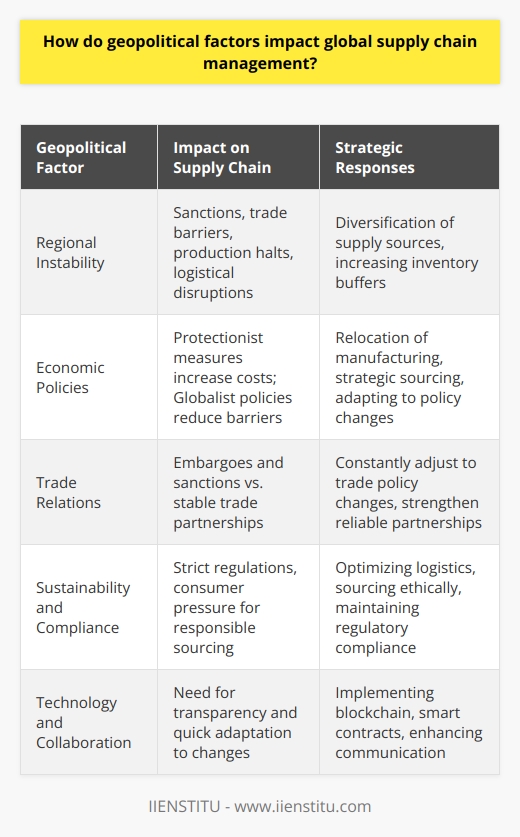
Source: DataCMS
Trade War Implications
Trade wars can throw a wrench in even the most carefully planned inventory strategies. Sudden tariffs or trade restrictions can dramatically alter the cost and availability of goods. Navigating these choppy waters requires a combination of agility, foresight, and strategic planning.
I’ve found that scenario planning for various trade war outcomes is essential for preparing contingency strategies. It’s not about predicting the future perfectly, but about being ready for a range of possible outcomes.
Diversification of supplier networks has proven to be a crucial strategy for mitigating risks from specific trade disputes. By spreading our sourcing across multiple countries or regions, we can reduce our exposure to any single geopolitical event.
Diversifying Supplier Networks
Putting all your eggs in one basket is risky, especially when it comes to inventory management. Diversifying your supplier network can provide a buffer against geopolitical disruptions, ensuring a more consistent inventory flow even when international relations get rocky.
I’ve implemented geographical diversification of suppliers to reduce exposure to regional political risks. This approach has helped maintain steady inventory levels even during periods of geopolitical tension.
Developing supplier performance metrics to evaluate and compare reliability across the network has been crucial in this process. These metrics help us make informed decisions about which suppliers to rely on more heavily during uncertain times.
Climate Change and Inventory Strategies
Climate change isn’t just an environmental issue—it’s an inventory management challenge too. Extreme weather events, changing consumer behaviors, and evolving regulations all impact how we optimize our inventory. Adapting to these changes is crucial for long-term success.
I’ve started incorporating climate risk factors into our inventory forecasting models. This involves analyzing historical weather data and climate projections to anticipate potential disruptions to our supply chain or shifts in demand patterns.
Developing sustainable inventory practices has become increasingly important, both for aligning with environmental regulations and meeting changing consumer expectations. This might involve using more eco-friendly packaging or optimizing transportation routes to reduce carbon emissions.
Sustainable Inventory Practices
Sustainability isn’t just a buzzword—it’s becoming a crucial factor in inventory optimization. Consumers are increasingly demanding environmentally friendly products and practices. By incorporating sustainability into our inventory strategies, we can meet these demands while also potentially reducing costs and improving efficiency.
I’ve been exploring the implementation of circular economy principles in our inventory management. This involves designing products for reuse, implementing take-back programs, and finding ways to repurpose or recycle unsold inventory.
Using eco-friendly packaging and storage solutions has been another focus area. Not only does this reduce our environmental impact, but it can also lead to cost savings in the long run.
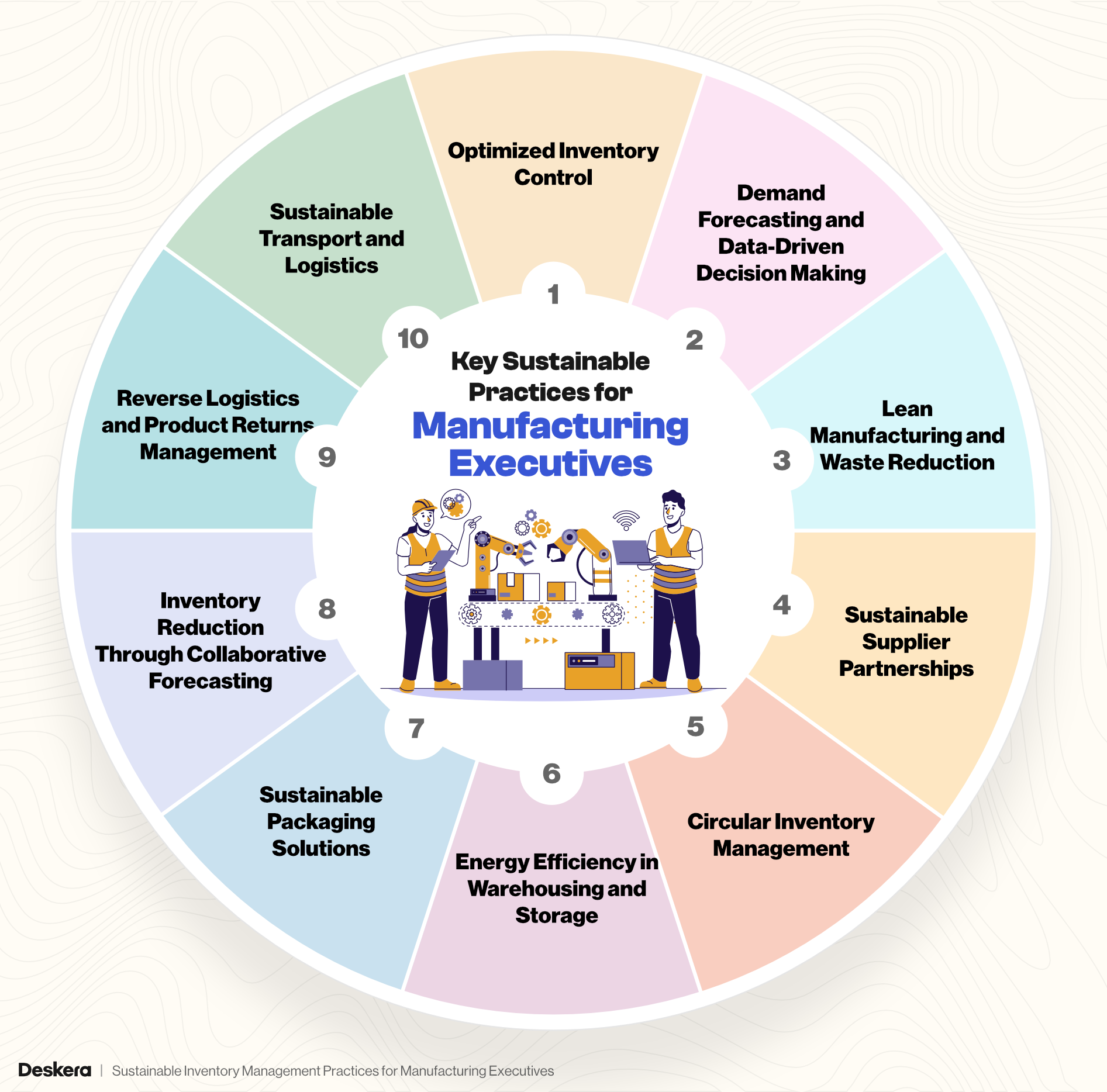
Source: Deskera
Climate Risk Assessment in Stock Management
Climate risks can significantly impact inventory management, from disrupting supply chains to altering demand patterns. Incorporating climate risk assessment into our inventory strategies can help us build more resilient and adaptive systems.
I’ve been working on integrating climate data into our inventory forecasting models. This involves considering factors like the increased frequency of extreme weather events and their potential impact on transportation routes or production facilities.
Developing contingency plans for climate-related supply chain disruptions has become a crucial part of our inventory strategy. These plans might include identifying alternative suppliers in different geographic regions or increasing safety stock for critical items during high-risk seasons.
Inventory Optimization in Emerging Markets
Emerging markets present both exciting opportunities and unique challenges for inventory optimization. From infrastructure limitations to rapidly changing market dynamics, managing inventory in these environments requires a specialized approach.
I’ve had to adapt our inventory models to account for infrastructure constraints in emerging markets. This might involve longer lead times due to less developed transportation networks or the need for more robust packaging to withstand challenging conditions.
Developing flexible inventory strategies to respond to rapid market changes has been crucial. In many emerging markets, consumer preferences and economic conditions can shift quickly, requiring us to be nimble in our inventory management.
The Role of Artificial Intelligence in Inventory Optimization
Artificial Intelligence is revolutionizing inventory optimization. From predictive analytics to autonomous decision-making systems, AI is enabling us to manage inventory with unprecedented accuracy and efficiency. But it’s not just about implementing AI—it’s about understanding how to leverage it effectively.
AI enables real-time optimization and predictive analytics in inventory management. I’ve seen how machine learning algorithms can adapt to changing market conditions for dynamic optimization, often outperforming traditional forecasting methods.
The recent launch of Pluto7’s AI-powered inventory positioning tool using Google Gemini 2.0 [CW33] demonstrates the rapid advancements in AI applications for inventory optimization. It’s exciting to see how these tools are making supply chain planners more effective in their roles.

Source: Medium
Natural Language Processing for Demand Forecasting
Natural Language Processing (NLP) is opening up new frontiers in demand forecasting. By analyzing customer sentiment, social media trends, and news articles, NLP can provide insights that traditional forecasting methods might miss. This can lead to more accurate inventory predictions and better-optimized stock levels.
I’ve been experimenting with NLP algorithms to process unstructured data from social media and news sources. The ability to gauge consumer attitudes through sentiment analysis has been particularly valuable in adjusting our inventory levels more proactively.
Integrating NLP-derived insights with our traditional forecasting methods has significantly improved our accuracy. It’s fascinating to see how combining these different approaches can provide a more comprehensive view of future demand.
Sentiment Analysis in Inventory Planning
Sentiment analysis takes the pulse of your customer base, helping you anticipate demand fluctuations before they show up in sales data. By incorporating this emotional data into your inventory planning, you can stay ahead of trends and optimize your stock levels more effectively.
I’ve implemented sentiment analysis tools to monitor social media and review platforms. This has given us valuable early warning signs of shifts in consumer preferences or potential issues with our products.
Developing sentiment score metrics to quantify consumer attitudes has been a game-changer. These metrics allow us to incorporate emotional data into our inventory forecasting models, resulting in more nuanced and accurate predictions.
Reinforcement Learning in Dynamic Inventory Optimization
Reinforcement learning is transforming how we approach dynamic inventory optimization. These algorithms can adapt to changing market conditions and optimize inventory levels in real-time, learning from each decision to improve future outcomes.
I’ve been impressed by how reinforcement learning algorithms can handle complex, multi-variable inventory decisions. They’re able to consider factors like seasonality, promotions, and competitor actions simultaneously, often finding optimal solutions that might not be immediately apparent to human planners.
The continuous learning and adaptation to market changes have significantly improved our optimization over time. It’s like having an AI assistant that gets smarter with each inventory decision we make.
A study by McKinsey found that companies using AI-powered inventory management systems reduced forecasting errors by 20-50%. This statistic aligns with my own experience, highlighting the potential of reinforcement learning in inventory optimization.
Multi-Agent Systems for Complex Supply Chains
Complex supply chains require sophisticated solutions. Multi-agent reinforcement learning systems can optimize inventory across interconnected networks, considering multiple stakeholders and variables simultaneously. It’s like having a team of AI experts working together to optimize your entire supply chain.
I’ve been involved in designing multi-agent systems to represent different supply chain entities. This approach allows us to model the complex interactions between suppliers, warehouses, and retailers more accurately.
Implementing collaborative learning algorithms for system-wide optimization has been a fascinating process. These algorithms allow the different “agents” in our system to learn from each other, leading to better overall performance.
Source: YouTube
Computer Vision in Warehouse Management
Computer vision is bringing a new level of accuracy and efficiency to warehouse management. From automated inventory counts to optimized picking routes, this technology is transforming how we track and manage physical inventory.
I’ve been involved in implementing computer vision systems for automated inventory tracking. These systems can perform continuous inventory counts, reducing the need for manual stock takes and improving accuracy.
Developing image recognition algorithms for product identification has been a game-changer. These algorithms can quickly and accurately identify products, even in cluttered warehouse environments, streamlining the picking and packing process.
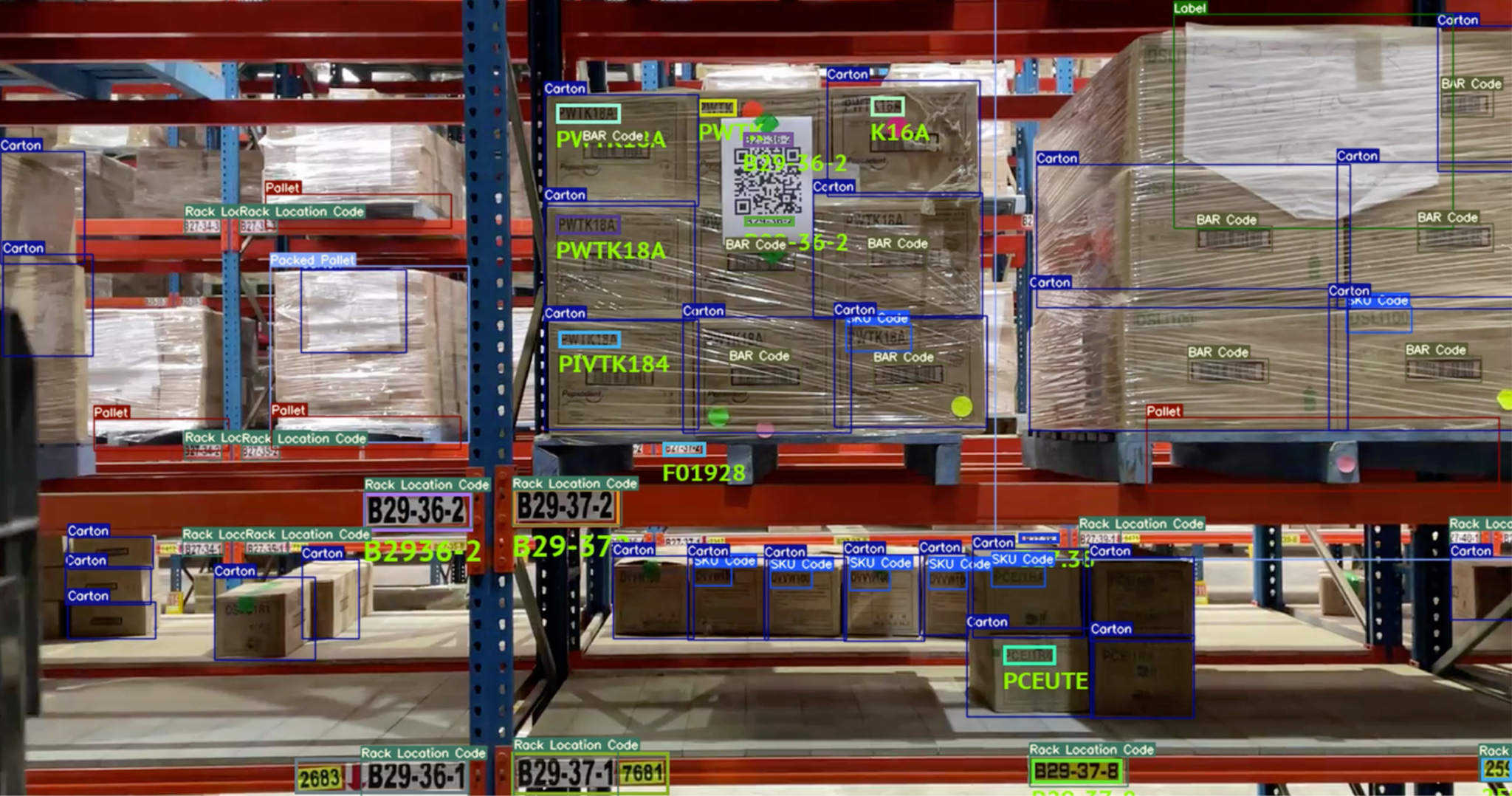
Source: NVIDIA
Blockchain
Blockchain and Inventory Transparency
Blockchain technology is set to revolutionize inventory management through enhanced traceability, reduced fraud, and improved stakeholder trust. By creating an immutable record of inventory transactions, blockchain can provide unprecedented transparency and efficiency in supply chain operations.
I’ve seen how blockchain enables secure, transparent record-keeping of inventory transactions. This technology creates a tamper-proof ledger that all stakeholders can trust, reducing disputes and improving collaboration across the supply chain.
Smart contracts are another exciting application of blockchain in inventory management. These self-executing contracts can automate and optimize inventory replenishment processes, ensuring timely payments and adjusting order quantities based on predefined conditions.
Smart Contracts for Automated Inventory Replenishment
Smart contracts are changing the game in inventory replenishment. These self-executing contracts can automate ordering processes, ensure timely payments, and even adjust order quantities based on predefined conditions. It’s like having a tireless, ultra-efficient inventory manager working 24/7.
I’ve been involved in developing smart contract templates for different inventory scenarios. These templates can be customized to fit various business needs, from simple reorder point systems to more complex vendor-managed inventory arrangements.
Integrating smart contracts with IoT devices for real-time inventory level monitoring has been particularly exciting. This integration allows for truly dynamic and responsive inventory management, with orders being triggered automatically based on real-time stock levels.
Implementing Decentralize d Inventory Systems
Decentralized inventory systems powered by blockchain can increase transparency, reduce fraud, and improve efficiency across the entire supply chain. By distributing the inventory ledger across multiple nodes, we create a more resilient and trustworthy system.
Designing blockchain architecture for decentralized inventory management has been a complex but rewarding process. We’ve had to consider factors like scalability, consensus mechanisms, and interoperability with existing systems.
Implementing consensus mechanisms for validating inventory transactions ensures that all parties agree on the state of the inventory at any given time. This has significantly reduced discrepancies and disputes in our supply chain.
Tokenization of Inventory Assets
Tokenization brings new flexibility to inventory financing and trading. By representing inventory as digital tokens on a blockchain, we enable more fluid movement of inventory assets, potentially opening up new markets and financing opportunities.
Creating digital tokens representing inventory assets on blockchain platforms has been an exciting venture. These tokens can represent anything from raw materials to finished products, allowing for more granular tracking and management of inventory.
Developing trading platforms for tokenized inventory assets has opened up new possibilities for inventory optimization. These platforms allow for more efficient allocation of resources across the supply chain, potentially reducing overall inventory levels while maintaining service levels.
Fractional Ownership in Inventory Management
Fractional ownership enabled by tokenization can revolutionize how we think about inventory. It allows for more flexible and collaborative inventory optimization strategies, potentially reducing costs and improving efficiency across the supply chain.
Designing fractional ownership models for inventory assets has been a fascinating challenge. We’ve had to consider issues like governance structures, profit-sharing mechanisms, and risk allocation among fractional owners.
Implementing profit-sharing mechanisms for fractional inventory ownership has required careful consideration of various stakeholders’ interests. These mechanisms need to be fair, transparent, and aligned with overall inventory optimization goals.
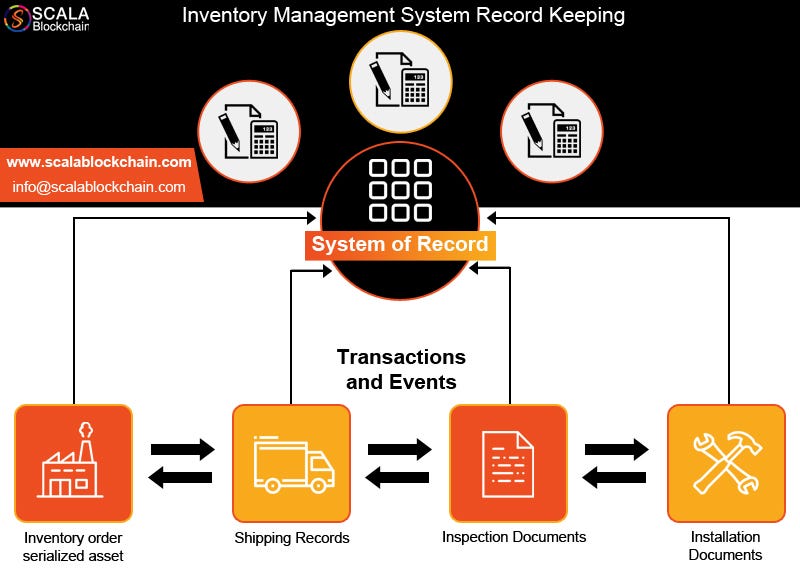
Source: Medium
Inventory Optimization Software and Tools
The right software can make or break your inventory optimization efforts. From cloud-based solutions to mobile apps, today’s inventory optimization tools offer powerful capabilities for businesses of all sizes. Understanding the landscape of these tools is crucial for choosing the right solution for your needs.
Cloud-based solutions offer real-time data access and multi-location management. This has been a game-changer for businesses with complex, geographically dispersed supply chains.
Advanced predictive analytics features have significantly improved forecasting accuracy and reduced costs. These tools can process vast amounts of data to identify patterns and trends that might be invisible to human analysts.
Research by Unleashed Software reveals that businesses using inventory management software are 67% more likely to report revenue growth than those using manual methods. This statistic underscores the importance of adopting advanced tools for inventory optimization.
| Feature | Cloud-Based Solutions | On-Premise Solutions |
|---|---|---|
| Data Access | Real-time, anywhere | Limited to local network |
| Scalability | Highly scalable | Limited by hardware |
| Cost Structure | Subscription-based | Large upfront investment |
| Maintenance | Handled by provider | In-house IT responsibility |
| Security | Provider-managed | Locally controlled |
Cloud-Based Inventory Optimization Solutions
Cloud-based platforms are reshaping inventory management. They provide real-time data access, scalability, and multi-location oversight. However, these advantages come with their own set of considerations and challenges.
Evaluating cloud security measures for protecting sensitive inventory data has been a top priority. We’ve had to ensure that our data is encrypted both in transit and at rest, and that access controls are robust.
Implementing data synchronization protocols for real-time inventory updates has been crucial for maintaining accuracy across our system. This ensures that all stakeholders have access to the most up-to-date information, regardless of their location.
API Integration for Seamless Data Flow
API integrations act as vital connectors in inventory optimization software. They facilitate smooth data exchange between inventory systems and other business tools, enhancing accuracy and enabling informed decision-making.
Designing API architecture for inventory data exchange has required careful consideration of data formats, authentication methods, and rate limiting to ensure system stability.
Implementing data validation and error handling in API integrations has been crucial for maintaining data integrity. This helps prevent bad data from propagating through the system and causing downstream issues.
Mobile Inventory Management Apps
Mobile applications bring inventory management to our fingertips. They enable instant updates and on-the-go decision-making, aligning perfectly with today’s fast-paced business environment. However, effective implementation requires careful consideration of user experience and security.
Designing user-friendly interfaces for mobile inventory management has been a key focus. We’ve had to balance the need for comprehensive functionality with the constraints of smaller screens and touch-based input.
Implementing secure authentication methods for mobile access has been crucial for protecting sensitive inventory data. This includes features like biometric authentication and multi-factor authentication.
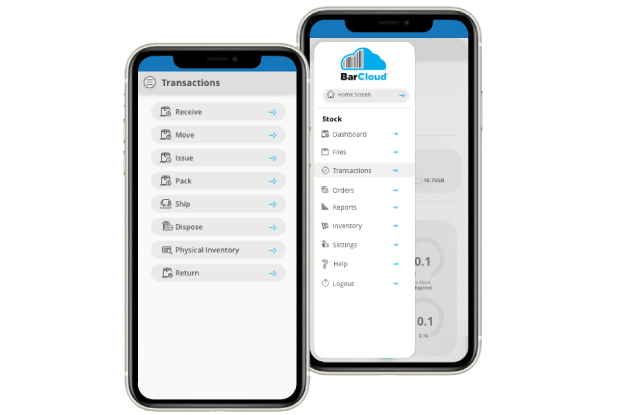
Source: ASAP Systems
Predictive Analytics in Inventory Optimization Tools
Predictive analytics serves as a crystal ball for inventory optimization. By analyzing historical data and current trends, these tools can forecast future demand with remarkable precision. This can lead to substantial reductions in carrying costs and improvements in customer satisfaction.
Implementing machine learning algorithms for demand forecasting has transformed our approach to inventory planning. These algorithms can identify complex patterns in data that traditional statistical methods might miss.
Integrating external data sources (e.g., economic indicators, weather data) for improved predictions has added another layer of accuracy to our forecasts. This holistic approach allows us to account for a wider range of factors that might impact demand.
Machine Learning Algorithms for Demand Forecasting
Machine learning algorithms are elevating demand forecasting to new heights. These sophisticated tools can identify patterns and relationships in data that humans might overlook, resulting in more accurate predictions and finely-tuned inventory levels.
Selecting and implementing appropriate machine learning models (e.g., ARIMA, neural networks) has been a process of experimentation and refinement. Each model has its strengths and weaknesses, and finding the right combination for our specific needs has been crucial.
Feature engineering to identify relevant variables for demand forecasting has been a key part of improving our models’ accuracy. This process involves both domain expertise and data analysis to determine which factors are most predictive of future demand.
A fashion retailer uses machine learning algorithms to analyze social media trends, weather patterns, and historical sales data. This approach allows them to predict demand for specific clothing items in different regions, optimizing their inventory allocation and reducing overstock situations.
Simulation and Scenario Planning Features
Simulation and scenario planning tools allow us to test various inventory strategies in a risk-free environment. By modeling diverse market conditions and supply chain disruptions, we can prepare for a range of potential futures and develop robust inventory optimization strategies.
Designing simulation models to accurately represent inventory dynamics has been a complex but rewarding process. These models need to capture the intricacies of our supply chain, including lead times, demand variability, and capacity constraints.
Implementing Monte Carlo methods for probabilistic scenario analysis has added a new dimension to our planning. This approach allows us to account for uncertainty and risk in our inventory decisions, leading to more resilient strategies.
Source: LinkedIn
Advanced Inventory Optimization Techniques
As businesses grow in complexity, so do their inventory optimization needs. Cutting-edge techniques like multi-echelon optimization and dynamic safety stock calculations are pushing the boundaries of inventory management. These sophisticated approaches consider the entire supply chain network to optimize inventory levels across multiple tiers simultaneously.
Multi-echelon optimization considers the entire supply chain network for holistic inventory management. This approach allows us to balance inventory levels across different stages of the supply chain, reducing overall costs while maintaining service levels.
Dynamic safety stock calculations adapt to real-time demand patterns and lead time variability. This ensures that we’re holding the right amount of safety stock at each location, reducing the risk of stockouts without tying up excess capital.
Multi-Echelon Inventory Optimization
Multi-echelon inventory optimization takes a comprehensive view of your supply chain. Instead of optimizing each stage independently, it considers the entire network to find the most effective overall inventory strategy. This approach can yield significant improvements in efficiency and cost savings.
Developing network models to represent multi-echelon supply chains has been a complex but rewarding process. These models need to capture the interdependencies between different stages of the supply chain, including transportation links and capacity constraints.
Implementing optimization algorithms for simultaneous inventory decisions across echelons has required sophisticated mathematical modeling. These algorithms need to balance the trade-offs between holding costs, transportation costs, and service levels across the entire network.
Network Design for Optimal Inventory Placement
Strategic network design is crucial for inventory optimization. It’s about finding the ideal location for inventory that minimizes overall costs while maintaining service levels. This involves meticulous analysis of transportation routes, demand patterns, and facility capabilities.
Utilizing network optimization algorithms to determine ideal inventory locations has transformed our approach to supply chain design. These algorithms can consider multiple factors simultaneously, finding solutions that might not be apparent through manual analysis.
Incorporating transportation costs and lead times into network design models ensures that we’re considering the full cost of inventory placement. This holistic approach often leads to counter-intuitive but highly effective inventory strategies.
Collaborative Planning, Forecasting, and Replenishment (CPFR)
CPFR extends inventory optimization beyond organizational boundaries. It’s a collaborative approach involving close cooperation with suppliers and customers to enhance forecasting accuracy and streamline replenishment processes. This shared responsibility can lead to substantial improvements in inventory efficiency.
Establishing data-sharing protocols with supply chain partners has been a crucial step in implementing CPFR. These protocols need to balance the need for transparency with data security and competitive concerns.
Implementing joint business planning processes for aligned inventory strategies has required a shift in mindset from all parties involved. It’s about moving from a transactional relationship to a truly collaborative partnership focused on mutual success.
Dynamic Safety Stock Optimization
Static safety stock levels are becoming obsolete. Dynamic safety stock optimization adjusts inventory buffers in real-time based on demand patterns, lead time variability, and service level requirements. This agile approach ensures preparedness for fluctuations without tying up excess capital.
Implementing algorithms to calculate optimal safety stock levels dynamically has been a game-changer for our inventory management. These algorithms can adjust safety stock levels in response to changes in demand variability, lead time reliability, and desired service levels.
Integrating real-time demand and lead time data into safety stock calculations ensures that our buffer levels are always appropriate for current market conditions. This responsiveness has significantly reduced both stockouts and excess inventory.
Machine Learning for Safety Stock Calculation
Machine learning is transforming safety stock calculations. These algorithms can process vast amounts of historical data and current market conditions to continuously refine safety stock levels. The outcome? More precise buffers that adapt to evolving business realities.
Selecting appropriate machine learning models for safety stock prediction has involved extensive testing and validation. We’ve experimented with various approaches, from traditional time series models to more advanced neural network architectures.
Incorporating diverse data sources (e.g., weather patterns, economic indicators) into ML models has improved the accuracy of our safety stock calculations. This holistic approach allows us to account for a wide range of factors that might impact demand variability or lead time reliability.

Source: Faster Capital
Inventory Pooling and Risk Pooling Strategies
Inventory pooling is a potent strategy for reducing overall stock levels while maintaining service quality. By centralizing inventory for multiple locations or product lines, you can leverage the statistical benefits of aggregation to reduce variability and lower total inventory requirements.
Developing mathematical models to quantify the benefits of inventory pooling has been crucial for gaining buy-in from stakeholders. These models demonstrate how pooling can reduce overall inventory levels without compromising service levels.
Implementing virtual pooling strategies for physically distributed inventory has allowed us to reap the benefits of pooling without the need for physical centralization. This approach uses advanced allocation algorithms to dynamically shift inventory between locations based on real-time demand.
Bulk By Pallet can leverage these advanced inventory optimization techniques to enhance their liquidation pallet offerings. By implementing AI-driven demand forecasting and dynamic safety stock optimization, they can provide resellers with more accurately curated pallets that align with current market trends. This approach ensures that resellers receive pallets optimized for quick sales and excellent margins.
Moreover, Bulk By Pallet can utilize inventory pooling strategies to efficiently manage their diverse range of liquidation stock. This could allow them to offer a wider variety of pallet options while minimizing overall inventory costs.
By embracing these cutting-edge inventory optimization methods, Bulk By Pallet positions itself as an innovative leader in the liquidation industry. Resellers looking for a competitive edge in their inventory sourcing should consider partnering with Bulk By Pallet for access to optimally curated liquidation pallets. Visit their website today to explore their offerings and take your reselling business to the next level.
Learnings Recap
- Inventory optimization is a multifaceted discipline that encompasses psychology, geopolitics, technology, and advanced mathematical techniques.
- Understanding cognitive biases and emotional intelligence can significantly improve inventory decision-making processes.
- Artificial Intelligence and Machine Learning are transforming inventory optimization, enabling more accurate forecasting and dynamic adjustments.
- Blockchain technology offers new possibilities for inventory transparency and asset management.
- Advanced techniques like multi-echelon optimization and dynamic safety stock calculations can lead to substantial improvements in inventory efficiency.
- Collaboration across the supply chain, through methods like CPFR, is crucial for holistic inventory optimization.






Add comment